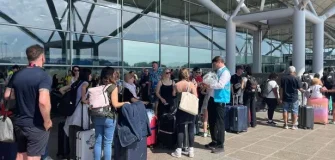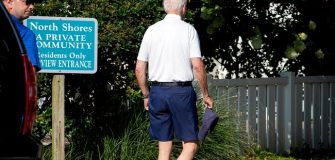How a would-be assassin’s bullet may have changed Trump, if not the race
Share
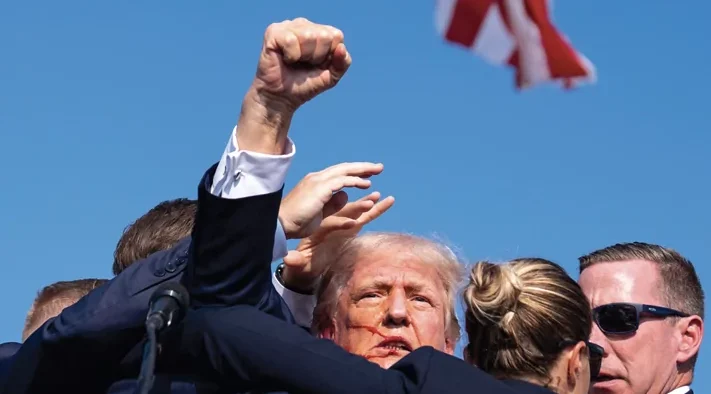
The Republican National Convention was supposed to mark the transformation of Donald Trump from presumptive GOP nominee to official standard-bearer of the party. But it turned out the real transformation took place 48 hours before the convention began, in a field in rural Pennsylvania, when Trump narrowly escaped an assassin’s attempt to blow his head off. In a split second, Trump suffered a bloody wound to his right ear and came away with a different view of his life and the presidential race. The effect on Trump was so pronounced that it seems reasonable to see Trump in two ways — the Trump of before the assassination attempt and after.
Trump had carefully planned the weekend before the convention began, on Monday, July 15, at Milwaukee’s Fiserv Forum. He would hold a rally in Butler, Pennsylvania, north of Pittsburgh, on Saturday evening, then fly back to his club in Bedminster, New Jersey, for the night, and then fly to Milwaukee late Sunday afternoon to begin the work that would culminate in his acceptance speech on the final night of the convention. I had made plans to travel with Trump from New Jersey to Milwaukee and to do an interview setting the stage for the convention.
The world knows what happened in Butler. In the early hours of Sunday, after Trump had been examined and treated at Butler Memorial Hospital and then returned to New Jersey, I thought Trump would surely change his plans and the interview would be off. Wouldn’t he take at least a day to rest? But the campaign said no, the plans had not changed, and Trump would be heading to Milwaukee as scheduled Sunday afternoon. He wasn’t going to let an assassination attempt stop him.
‘I’m supposed to be dead’
On Trump’s customized Boeing 757, colloquially known as Trump Force One, the former president, with a white gauze bandage on his ear that the public had not yet seen, seemed to go back and forth between his old self and a man trying to process what had just happened to him. On the same-old-Trump side, the first thing Trump brought up when I sat down with him was his vice presidential pick. He did not reveal what he was thinking — less than 24 hours later he would announce it was Sen. J.D. Vance (R-OH) — but Trump always wants to know what’s going on: What are people saying about Rubio? What about Burgum? Anybody else?
But then, inevitably, the talk turned to the day before. Trump became a little quieter. He could not stop thinking about, and reliving, the moment the bullet struck.
Trump explained that he normally stands at the podium and faces the crowd as he speaks. If he had been in that position when the shooter pulled the trigger, he would have been killed instantly. But on this evening, Trump had brought a visual aid: a chart with statistics about immigration that was showing on a large screen to Trump’s right. As he referenced the information in the chart, Trump turned his head so that he was facing almost directly right. And in that nanosecond, when his head was in that position, the bullet whizzed by, grazing his ear. If Trump had been facing a little more forward, the shot would have been fatal.
Instead, his head happened to be in the precise spot that ensured his survival. How did that happen? “The most incredible thing was that I happened to not only turn but to turn at the exact right time and in just the right amount,” Trump told me. “If I only half-turn, it hits the back of the brain. The other way goes right through [the skull]. And because the sign was high, I’m looking up. The chances of my making a perfect turn are probably one-tenth of 1%, so I’m not supposed to be here.”
Trump returned to that moment, and the nearness of death, over and over as we talked. “I had to be at the exact right angle,” Trump said at another point. “Because the thing was an eighth of an inch away. That I would turn exactly at that second, where he [the gunman] wouldn’t stop the shot is pretty amazing. Pretty amazing. I’m really not supposed to be here.”
“I mean, I’m supposed to be dead,” Trump said later. “I’m not supposed to be here.”
Trump has a big TV screen in clear view from his regular seat on the plane. As we spoke, a newscast came on, and he watched video of himself being shot. “Look at that, they’re showing the bullet — holy s***! — can you believe those crazy pictures?” he exclaimed when the program showed the extraordinary photo of the bullet trail streaking away from him after he was hit.
A changed man?
It was clear that Trump felt something very important had changed in his life. How could he not? There has been a lot of research on the effects of near-death experiences, and they are often profound. At the very least, Trump was grappling with all sorts of new and powerful feelings. You could actually see it on his face, both in the plane and when Trump made his first public appearance Monday night at the convention. The public has never seen Trump look so emotional as when he walked into the Fiserv Forum on that first night.
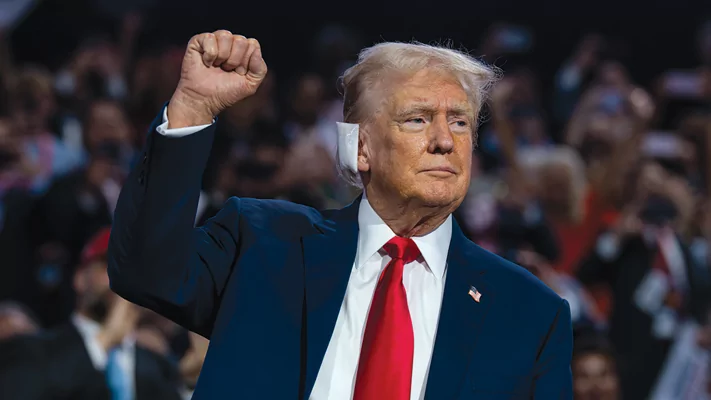
Some people have cited a quote from Winston Churchill — “Nothing in life is so exhilarating as to be shot at without result” — in describing Trump. And indeed, Trump seemed very happy not to be dead. But his reaction was more subdued than exhilarated. He was, after all, wounded, if not seriously, by the bullet. And the brush with death seemed to leave him in a deeply thoughtful frame of mind.
When I asked Trump whether the assassination attempt would change his campaign, he answered “yes” before I finished the question. In the hours since the shooting, he had been looking back on his nine years in presidential politics, seeing the time as one battle after another. “I’ve been fighting a group of people that I considered very bad people for a long time and they’ve been fighting me, and we’ve put up a very good fight,” Trump said. Now, after the shooting, Trump said he feels he can’t keep up the same thing “after what I’ve been through.”
Trump said he felt he had to take a different approach to his convention acceptance speech. He couldn’t be the same old Trump because he wasn’t the same old Trump. He explained that before the shooting, he had already prepared the speech, and it was “an unbelievable rip-roarer — it was brutal, really good, really tough.” But after the shooting, he decided to throw it out in favor of a speech that was less tough and “more unifying.”
“Unity” quickly became a buzzword in the campaign and at the convention. Of course, it was true in the sense that the attack on Trump further united Republicans who were already solidly united behind Trump. But the idea was to create a greater unity among those who didn’t support Trump, a national unity behind a former and would-be president. People in Trumpworld did not think he could make that happen with words alone, but if he is elected, the positive results and recovery from President Joe Biden’s various disasters would unite the country behind Trump.
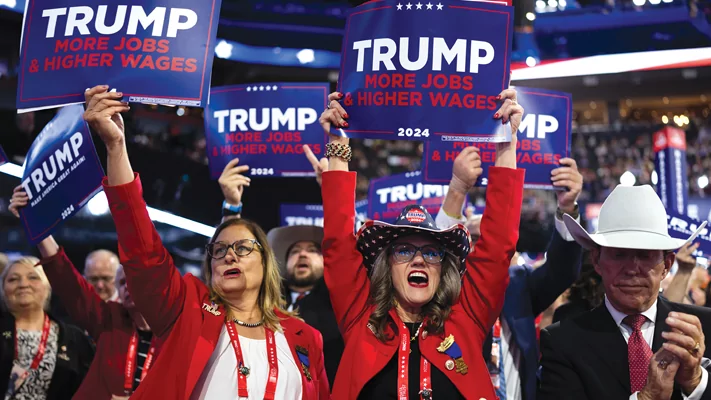
It sounds good, but how does that actually happen? First, it is not clear whether Trump’s change in outlook in the days following the shooting will last. He is a 78-year-old man with a powerful personality that has remained pretty much the same for a very long time. Over the years, a lot of his supporters have hoped that Trump could change this or that aspect of his personality to become a less controversial leader, and they have been disappointed. So we will see what happens in coming months.
And if he is elected, yes, Trump might achieve good results, but he got good results in his first term, and Democrats spent the entire time trying to remove him from office. If he were to be elected again, and if Democrats control at least one house of Congress, it seems likely that that effort would begin again even before Trump is inaugurated. His adversaries will renew their attempt to disqualify Trump via the 25th Amendment, and if Democrats control the House, it seems highly likely they will impeach him on Day 1 based on Jan. 6 and his criminal conviction in New York and who knows what else. Trump would have to fight back, which would be his instinct anyway. The nation’s politics would be as divided as ever. And people would talk about how united the country seemed for about a minute and a half during the summer.
Still, there was a real contrast between the after-the-shooting Trump I spoke to on the plane on July 14 and the Trump of before the shooting. From my own observation, the contrast was particularly apparent comparing the trip to Milwaukee with a visit with Trump just a month earlier, on June 11, when we talked at dinner in Florida and then headed off on another flight, this one to Washington, D.C.
Before and after
I had gone to Mar-a-Lago to take a look at what might be called the campaign you don’t see. As a former president, Trump no longer has use of the White House and Air Force One. But as a billionaire, he has two reasonable facsimiles: a historic mansion, Mar-a-Lago, and a giant, luxurious airplane, Trump Force One. That allows him to run a sort of White House campaign operation without the actual White House. If you are, say, a Republican member of Congress or part of a trade group or a religious organization or a social media influencer or a state legislator, a visit with Trump at Mar-a-Lago, especially if it includes a ride on the 757, can seem almost like a presidential event.
Trump makes full use of his assets. The day I visited, he had hosted businesspeople; members of a bitcoin group hoping for favorable treatment in the next administration; a lawmaker, Sen. Bill Hagerty (R-TN); and a YouTube influencer, WWE wrestler and podcaster Logan Paul. He also put in a lot of time on the phone, making fundraising calls and calls to various state officials, plus radio shows and media interviews. On top of that, Trump decided to go to Washington for meetings with House and Senate Republicans, so after dinner, it was off to the plane and a lot more calls. It was all done with little media coverage — another busy day in the campaign you don’t see.

A conversation with Trump can go all over the place. At dinner, we talked about his criminal conviction in Manhattan, a week and a half earlier, on 34 felony charges that his supporters, and others as well, believe were politically motivated. Trump told me he was quite surprised to be indicted in the first place after so many legal experts he knew, many of them on television, told him the case had no merit. He was appalled, and then he was surprised again, this time positively.
“I had no idea it would make me more popular,” Trump said. “I had no idea it would set fundraising records, numbers like nobody’s ever seen before.” Politically, he said, “if anything, it has hardened our base. I was a little bit surprised and very pleasantly surprised. When the government goes after you like this, who goes up in the polls?”
Still, it was not hard to see a certain ambivalence. Before I joined Trump for dinner, there was a brief and telling scene when he recorded a podcast with Logan Paul. When they met, Trump gave Paul a MAGA hat and a mug shot T-shirt. “Is this your mug shot?” Paul asked.
“Yeah,” Trump said. “Can you believe it?”
“You’re a gangster!” Paul said admiringly.
“This is what we’re reduced to,” Trump said. “Isn’t it crazy?” He then noted that Elvis Presley and Frank Sinatra both had legendary mug shots, “but we’ve eclipsed them.”
“It is what it is,” Trump said. In the entire exchange, there was more wistfulness than swagger in his demeanor. But being Trump, if he had to have a mug shot, it was going to be the best mug shot.
At dinner, Trump then moved on to the debate with Biden, at that time still two weeks in the future. Trump explained his thinking in accepting Biden’s debate challenge so quickly. He said he believed Biden didn’t really want to debate and made Trump an offer he thought Trump would refuse. It was all for show. Instead, Trump accepted almost instantly, and Biden was locked into a debate that would prove disastrous for him. That led to an extended discussion of Biden and…face-lifts.
“This guy is shot,” Trump said of Biden. “He also had really bad plastic surgery. You know, his eyes are round. He had a face-lift. I’ll tell you what happened. Outside of the hair, which was very bad, he was sort of a good-looking guy. Bad hair, but he was sort of a good-looking guy, and he was hale and hearty.”
“He was very late into the campaign,” Trump continued. “And if you saw him when he first came into the campaign, he was a mess. I mean, it was terrible. He had terrible plastic surgery.” (In 2019, as the Democratic presidential primary contest got underway, a number of cosmetic surgeons told the Washington Examiner that Biden showed signs of having had cosmetic surgery.) “His eyes were round,” Trump repeated. “They’re like pennies. You know, eyes are supposed to be aligned … his eyes are absolutely round if you look at him, the skin around his eyes. Whoever did the plastic surgery was terrible. And it took him a while, and now he’s much better than he was. I was shocked that he won [the 2020 Democratic nomination] because to me, every time I look at it, it’s holy s*** — it’s just bad plastic surgery.”
It became clear that Trump can discuss plastic surgery at great length. So I asked whether Trump watched Biden very much. “No, as little as possible,” he said. “Well, you’ve got to study him a little?” I said. “Look, I’ve been studying,” Trump answered. “Don’t worry about that. I’ve been studying.”
As dinner wound down, Trump said it was time to head to the plane for the trip to Washington Dulles International Airport. Trump was in a good mood. It was a Tuesday night, and there had been several Republican primaries around the country, and Trump’s candidates won. He spent a good deal of time making congratulatory phone calls.
On the plane, Trump’s mood seemed lighter, more playful, happier. He loves music and has given himself the de facto role of musical director at Mar-a-Lago, using his iPad to pick songs for the diners. He can flip through songs very fast. On the plane, he gave a tour, a pretty high-volume tour, of some of his favorite music videos on the big TV screen.
He started with Guns N’ Roses’s “November Rain,” a lengthy and elaborate video whose production values Trump discussed in great detail. Next was Sinead O’Connor’s “Nothing Compares 2 U,” which Trump liked so much he played two different versions. Next was James Brown and Luciano Pavarotti’s version of Brown’s “It’s a Man’s Man’s Man’s World.” Trump knows the song is wildly politically incorrect by today’s standards, but he is a big fan of both Brown and Pavarotti. He knew the opera singer and paid Pavarotti a great Trumpian compliment: “He was a wild man.” Trump bestowed the same honor on Brown, who certainly deserved it, too.
As the videos played, Trump would occasionally stop and talk or take a phone call. Next, he played a video of Brown’s legendary performance of “Please, Please, Please” at the 1964 T.A.M.I. Show. Then it was on to Presley’s medley of “Dixie” and “Battle Hymn of the Republic.” (Trump has been playing more Elvis at his rallies these days, for what it’s worth.) The last video of the evening was one of Trump’s favorites, the Rolling Stones’s “You Can’t Always Get What You Want,” which he used to use to close his rallies.
CLICK HERE TO READ MORE FROM THE WASHINGTON EXAMINER
On the flight went, with music, conversation, and phone calls, Trump in the center of it all. It was kind of a small, flying party heading from Florida to Washington, with the host in good spirits, keeping the hits coming. No one knew that a month later, Trump would be in the same place, the same seat, a bandage on his head, eyes on the same big screen, watching videos not of Brown or O’Connor but of a gunman trying to assassinate him. No one knew he would be replaying the experience in his mind, reflecting on how close he came to dying. No one knew he would be wondering why he was allowed to live — “by luck or by God,” he said. And no one knew that he would be rethinking his entire campaign, the presidency, and his appeal to the people.
Maybe the 2024 race will return to normal, although it would be hard to say that anything about the race has been normal so far. But something has changed in Trump. Even if he returns to the combative style that has characterized his career in national politics, the assassination attempt has exposed a depth and contemplativeness that voters have never seen in him before.
Byron York is the chief political correspondent for the Washington Examiner.









